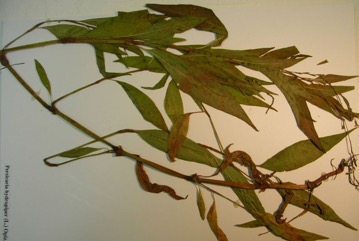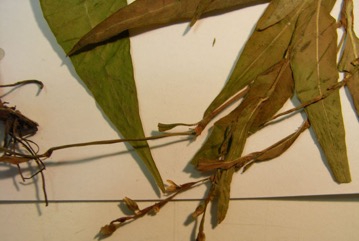Water pepper, Marshpepper Smartweed

It is a temperate plant. It grows in shallow water along the edges of creeks and rivers. It grows in wetlands. It grows in open waste places. It suits sunny wet locations. It can grow from the seashore to 1500 m altitude. Tasmania Herbarium. In Yunnan. In Sichuan.
Also known as:
Agagat, An ji ba qian, Behu, Bislangi, Buding, Cacabean, Common smartweed, Daun senahun, Ganeri, Ngh(eer) n(uw)(ows)c, Ngh(eer) r(aw)m, Numshim-muk, Packur mul, Pani-maricha, Papreni lisac, Pha chi mi, Phak phai nam, Pungent smartweed, Ram-nuoc, Ratnaulo, Rumput tuboh, Si tuba sawah, Smartweed, Tade, Tuba, Tube seluwang, Water pepper, Yanagi-tade
Synonyms
- Persicaria acris Gilib.
- Persicaria hydropiper (L.) Opiz
- Persicaria hydropiper (L.) Spach
- Persicaria vernalis Nakai
- Peutalis hydropiper Raf.
- Polygonum hecasanthum Schur
- Polygonum hydropiper L.
- Polygonum koreense Nakai
- Polygonum obtusifolium Schur
- Polygonum oleraceum Schur.
- Polygonum shinzii J. Schust.
Edible Portion
- Leaves, Seeds, Leaves - spice, Leaves - tea
Where does Water pepper grow?
Found in: Asia, Australia, Balkans, Bangladesh, Bhutan, Bosnia, Britain, Canada, Central Asia, China, Europe, Himalayas, India, Indochina, Indonesia, Japan, Kazakhstan, Korea, Kyrgyzstan, Luxembourg, Macedonia, Malaysia, Mongolia, Myanmar, Nepal, North America, Northeastern India, Pacific, Pakistan, Philippines, Russia, SE Asia, Sikkim, Slovenia, Sri Lanka, Tasmania, Thailand, United States, Uzkebistan, Vietnam
Notes: Chemical composition (Chinese sample): Protein = 7.54%. Fat = 1.86%. Carbohydrate = 7.99%. Ash = 1.99%. There are about 50 Polygonum species.
Status: It is used as a hot spicy pepper for seaweeds in Japan. It is sold in local markets in China.
Growing Water pepper, Marshpepper Smartweed
Edible Uses: The stems and leaves are eaten. Young leaves have a strong peppery taste and are used to flavour food. They are finely chopped. The stalks are roasted, then peeled and eaten. The acrid juice is used as a spice. The young seedlings are used to garnish many dishes.
Nutrition Info
per 100g edible portion| Edible Part | Energy (kcal) | Protein (g) | Iron (mg) | Vitamin A (ug) | Vitamin c (mg) | Zinc (mg) | % Water |
|---|---|---|---|---|---|---|---|
| - | - | - | - | - | - |
Water pepper, Marshpepper Smartweed Photos


References
Altschul, S.V.R., 1973, Drugs and Foods from Little-known Plants. Notes in Harvard University Herbaria. Harvard Univ. Press. Massachusetts. no. 848 (As Polygonum hydropiper)
Ambasta, S.P. (Ed.), 2000, The Useful Plants of India. CSIR India. p 480 (As Polygonum hydropiper)
Arora, R. K., 2014, Diversity in Underutilized Plant Species - An Asia-Pacific Perspective. Bioversity International. p 44 (As Polygonum hydropiper)
Bodkin, F., 1991, Encyclopedia Botanica. Cornstalk publishing, p 819 (As Polygonum hydropiper)
Burkill, I.H., 1966, A Dictionary of the Economic Products of the Malay Peninsula. Ministry of Agriculture and Cooperatives, Kuala Lumpur, Malaysia. Vol 2 (I-Z) p 1823 (As Polygonum hydropiper)
Cerne, M., 1992, Wild Plants from Slovenia used as Vegetables. Acta Horticulturae 318. (As Polygonum hydropiper)
Chen, B. & Qiu, Z., Consumer's Attitudes towards Edible Wild Plants, Ishikawa Prefecture, Japan. p 24 www.hindawi.com/journals/ijfr/aip/872413.pdf (As Polygonum hydropiper)
Cherikoff V. & Isaacs, J., The Bush Food Handbook. How to gather, grow, process and cook Australian Wild Foods. Ti Tree Press, Australia p 196 (As Polygonum hydropiper)
Cooper, W. and Cooper, W., 2004, Fruits of the Australian Tropical Rainforest. Nokomis Editions, Victoria, Australia. p 404
Cribb, A.B. & J.W., 1976, Wild Food in Australia, Fontana. p 126 (As Polygonum hydropiper)
Curtis, W.M., 1993, The Student's Flora of Tasmania. Part 3 St David's Park Publishing, Tasmania, p 590 (As Polygonum hydropiper)
Deka, N. & Devi, N., 2015, Wild edible aquatic and marshland angiosperms of Baka district, BTC area, Assam, India. Asian J. Plant Sci. Res. 5(1):32-48
Duke, J.A., 1992, Handbook of Edible Weeds. CRC Press. p 154 (As Polygonum hydropiper)
Elliot, W.R., & Jones, D.L., 1997, Encyclopedia of Australian Plants suitable for cultivation. Vol 7. Lothian. p 204
Facciola, S., 1998, Cornucopia 2: a Source Book of Edible Plants. Kampong Publications, p 185
Flora of Pakistan. www.eFloras.org
Foo, J.T.S.(ed), 1996, A Guide to Common Vegetables. Singapore Science Foundation. p 124 (As Polygonum hydropiper)
Hani Medicine of Xishuangbanna, 1999, p 103 (As Polygonum hydropiper)
Hist. nat. veg. 10:536. 1841
Hu, Shiu-ying, 2005, Food Plants of China. The Chinese University Press. p 372 (As Polygonum hydropiper)
Huq, A. K. M. M., Jamal, J. A. and Stanslas, J., 2014, Ethnobotanical, Phytochemical, Pharmacological, and Toxicological Aspects of Persicaria hydropiper (L.) Delarbre, Evidence-Based Complementary and Alternative Medicine, pp.1-5.
IRVINE, (As Polygonum hydropiper)
Irving, M., 2009, The Forager Handbook, A Guide to the Edible Plants of Britain. Ebury Press p 174
Kiple, K.F. & Ornelas, K.C., (eds), 2000, The Cambridge World History of Food. CUP p 1797 (As Polygonum hydropiper)
Kumar, Y J. et al, 1987, Further Contribution to the Ethnobotany of Meghalaya: Plants used by "War jaintia" of Jaintia Hill District. Econ. Tax. Bot. Vol 11 No. 1 pp 65- (As Polygonum flaccidum)
Lamp, C & Collet F., 1989, Field Guide to Weeds in Australia. Inkata Press. p 225 (As Polygonum hydropiper)
Larkcom, J., 1991, Oriental Vegetables, John Murray, London, p 130 (As Polygonum hydropiper)
Lazarides, M. & Hince, B., 1993, Handbook of Economic Plants of Australia, CSIRO. p 194 (As Polygonum hydropiper)
Li, D. et al, 2017, Ethnobotanical survey of herbal tea plants from the traditional markets in Chaoshan, China. Journal of Ethnopharmacology. 205 (2017) 195-206 (As Polygonum hydropiper)
Low, T., 1992, Bush Tucker. Australia’s Wild Food Harvest. Angus & Robertson. p 185 (As Polygonum hydropiper)
Luo, B., et al, 2019, Wild edible plants collected by Hani from terraced rice paddy agroecosystem in Honghe Prefecture, Yunnan, China. Journal of Ethnobiology and Ethnomedicine 15:56 (As Polygonum hydropiper)
MacKinnon, A., et al, 2009, Edible & Medicinal Plants of Canada. Lone Pine. p 322
Martin, F.W. & Ruberte, R.M., 1979, Edible Leaves of the Tropics. Antillian College Press, Mayaguez, Puerto Rico. p 99, 214 (As Polygonum hydropiper)
Moerman, D. F., 2010, Native American Ethnobotany. Timber Press. p 424
Pham-Hoang Ho, 1999, An Illustrated Flora of Vietnam. Nha Xuat Ban Tre. p 749 (As Polygonum hydropiper)
Plants for a Future database, The Field, Penpol, Lostwithiel, Cornwall, PL22 0NG, UK. http://www.scs.leeds.ac.uk/pfaf/ (As Polygonum hydropiper)
PROSEA handbook Volume 13 Spices. p 259
Rana, D., et al, 2019, Ethnobotanical knowledge among the semi-pastoral Gujjar tribe in the high altitude (Adhwari’s) of Churah subdivision, district Chamba, Western Himalaya. Journal of Ethnobiology and Ethnomedicine (2019) 15:10
READ, (As Polygonum hydropiper)
Redzic, S. J., 2006, Wild Edible Plants and their Traditional Use in the Human Nutrition in Bosnia-Herzegovina. Ecology of Food and Nutrition, 45:189-232 (As Polygonum hydropiper)
Romanowski, N., 2007, Edible Water Gardens. Hyland House. p 77
Savita, et al, 2006, Studies on wild edible plants of ethnic people in east Sikkim. Asian J. of Bio Sci. (2006) Vol. 1 No. 2 : 117-125 (As Polygonum hydropiper)
Shikov, A. N. et al, 2017, Traditional and Current Food Use of Wild Plants Listed in the Russian Pharmacopoeia. Frontiers in Pharmacology. Vol. 8 Article 841
Swapna, M. M. et al, 2011, A review on the medicinal and edible aspects of aquatic and wetland plants of India. J. Med. Plants Res. 5 (33) pp. 7163-7176 (As Polygonum hydropiper)
Tasmanian Herbarium Vascular Plants list p 45
Terra, G.J.A., 1973, Tropical Vegetables. Communication 54e Royal Tropical Institute, Amsterdam, p 68 (As Polygonum hydropiper)
van Wyk, B., 2005, Food Plants of the World. An illustrated guide. Timber press. p 286
Wang, J. et al, 2013, A Study on the Utilization of Wild Plants for Food in Liangshan Yi Autonomous Prefecture. Plant Diversity and Resources. 35(4): 416-471 (As Polygonum hydropiper)
Williams A. & Sides, T., 2008, Wiradjuri Plant Use in the Murrumbidgee Catchment. Murrumbidgee Catchment Management Authority. Wagga Wagga, p 90
World Checklist of Useful Plant Species 2020. Royal Botanic Gardens, Kew
Wujisguleng, W., & Khasbagen. K., 2010, An integrated assessment of wild vegetable resources in Inner Mongolian Autonomous Region, China. Journal of Ethnobiology and Ethnomedicine 6:34 (As Polygonum hydropiper)
www.eflora.org Flora of China (As Polygonum hydropiper)
Xu, You-Kai, et al, 2004, Wild Vegetable Resources and Market Survey in Xishuangbanna, Southwest China. Economic Botany. 58(4): 647-667. (As Polygonum hydropiper)
Zhang, Y., et al, 2014, Diversity of wetland plants used traditionally in China: a literature review. Journal of Ethnobiology and Ethnomedicine. 10:72 (As Polygonum hydropiper)